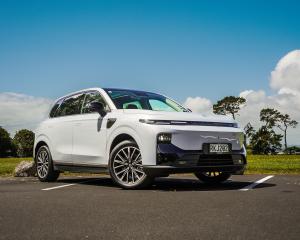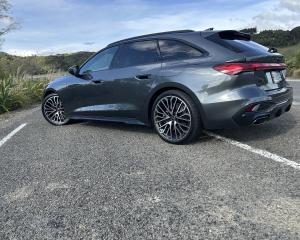
ROAD TEST
What’s new?
Both a credible new player for Suzuki in the compact crossover class, and a replacement for the Japanese marque’s discontinued Baleno hatchback, the recently launched Fronx is already proving a local hit.
The initial batch of 300 vehicles sold out within weeks at a $29,990 introductory price, and even with the regular $31,990 tag now applying, strong interest continues in a new-car market that has quietly picked up in recent months after a pretty lean time.
Though curiously named — Fronx is a portmanteau of "frontier next" — this new arrival is in all key respects a conventional machine.
Its underlying platform is, in fact, that of the Baleno, tried and true since it’s been around for a decade. The non-turbo 1.5-litre engine that nestles under the bonnet is familiar here too, currently from its use in the diminutive Jimny 4x4. As deployed for the Fronx, though, it’s supplemented by a mild-hybrid electric system that involves a very small lithium-ion battery to power a supplementary electric motor-cum-generator.
The electric power barely shifts the dial when it comes to peak outputs, these being roundly 76kW of power and 137Nm of torque. What it does, though, is lend a helping hand for short periods such as when accelerating away from rest. It also recovers energy to recharge the battery when the vehicle is coasting or braking. Power delivery is to the front wheels, via a conventional six-speed automatic transmission.
Like the Jimny 5-door, the Fronx comes of a production line in India rather than Japan, but actually from a different factory in a different state; India, incidentally, is a more important manufacturing base for Suzuki than Japan these days, and various models produced there (Fronx included) are even exported back to Japan.

What does it look like?
Styling is tidily middle-of-the-road, with a bluff nose, rising waist and coupe-like roof line that are very much in vogue for compact crossovers these days.
And though you might not pick it at a glance, compact the Fronx certainly is, measuring up at just 3995mm long. That’s shorter than pretty much all of its rivals, and indeed only 135mm longer than the latest Swift, though obviously the Fronx stands a lot taller, at 1765mm versus the Swift’s 1485mm.
Suzuki’s distinctive S badge is writ large in the middle of the grille and in smaller font on the tailgate. Plastic wheelarch mouldings and faux scuff plates front, rear and along the sills suggest an offroad capability that the Fronx certainly doesn’t have, despite an adequate 170mm of ground clearance.
Good things seem to come in threes when it comes to the lights, with triple clusters (all LEDs) featuring in both the main and auxiliary light units up front and in the claw-like lighting arrangement at the rear. Wheel and rubber-wise 16-inch alloys shod with 195/60 tyres are standard fare.
For those wanting to make something of a visual splash, there’s striking red and vibrant orange paint options, and — for a $1000 premium — a two-tone option that provides a black roof and pillars. The test car, though, was finished in a more modest single-tone blue.
What comes as standard?
With just the one specification on offer, the Fronx’s equipment list is fairly straightforward, but also comprehensive at this price point.

Curiously given that the year is 2025, the sole USB plug point up front is the old A-type socket, while there are both USB-A and USB-C plug points in the back. More firmly on the minus side side there’s no auto-wiper function, no spare wheel (just an emergency repair kit) and the steering column only adjusts for rake, not reach.
Fronx’s safety suite includes adaptive radar cruise control, lane-keeping assist and lane departure warning, blind-spot monitoring, rear cross-traffic alert, traffic sign and speed limit recognition, and automated emergency braking. Absent, but not necessarily missed on test, are over-speed warning chimes and a driver attention alert warning.
What’s it like inside?
While its exterior dimensions may be compact, the Fronx cabin is surprisingly spacious.
This is especially so up front, where the reasonably high-set seating position also ensures good visibility and light trim above the waistline contributes to an airy feel.
A preponderance of hard plastic trims is no surprise in this segment of the market, but everything seems well assembled. Contrasting surface finishes and the dominant centre screen add some vim to the dash and door panels.
The Fronx’s native interfaces for the touchscreen are easy to use, but smartphone mirroring (simply accomplished) will be preferable for many, and also essential for navigation, as there’s no in-built navigation system. The touchscreen’s display is bright and clear, though its gloss finish is quite prone to smudging, which can be distracting in certain lights.

The seats themselves are remarkably swish at this price point, being snug sports-style buckets trimmed in a mix of patterned cloth and black and burgundy faux leather trim. The burgundy trim element also carries over to the door inserts and some sections of the lower dash.
Providing decent head and legroom, but really too narrow to accommodate three adults, the rears seats are reasonably comfortable, though with the downsides of no rear air vents, and no fold-down centre armrest. Child seat anchor points are provided for all three rear seat positions.
Boot space is an adequate 304 litres, doubling to 605 litres when the 60:40 split rear seats are folded down. The sides of the boot contain small oddment nooks, and there is extra "hidden" stowage space beneath the boot floor.
What’s it like to drive?
Overall, the Fronx is an easy and undemanding drive, with a light and nimble nature that is handy around town, and can even be quite entertaining down winding back roads.
Settling in behind the wheel, the driving position is comfortable. Though having just rake and no reach-adjustment for the steering wheel is not ideal, some compensation is provided by the significant level of height adjustability for the driver’s seat squab.
Key controls and instruments are sensibly placed, and while the prominent touchscreen places the Fronx firmly in the digital age, there’s still a primary reliance on clearly labelled conventional buttons and switches.
The mild hybrid system’s electric assist is unobtrusive, lending a hand most importantly when accelerating from rest, or from slow speeds. The extra shove of low-down torque it provides aids refinement, low-speed acceleration and economy, and is particularly important as the petrol engine is quite modest in its peak power and torque outputs, and neither are produced until quite high in the rev range.

To extract the most from the drivetrain can offer there’s a sport mode and — as quite a surprise at this price points — paddle-shift controls. There’s also an "M" (Manual) mode on the gearshift. Whether left to its own devices or manually controlled, the six-speed automatic shifted smoothly.
Economy-wise the Fronx is rated at 5.4l/100km on the standard WLTP test regime and is happy on a diet of 91 octane petrol. When I collected the test car for appraisal it had achieved a 6.0l/100km return over its life, and that’s what I managed too over a week of winter driving, split roughly 50:50 time-wise between around town and open road.
Being, compact, light, and possessed of quite strongly assisted steering, the Fronx is a very easy vehicle around town. Although the resolution of its cameras could be a little better, having a 360-degree surround-view system takes a lot of hassle and uncertainty out of parking too.
Beyond city limits, but away from the main highway haul, the Fronx is more fun than you might expect to thread down a winding road. Again, the fact that it weighs not much more than a tonne is big plus. This aids initial turn-in, means the tyres don’t have to work too hard to maintain lateral grip, and gives an ease to rapid changes of direction that larger or heavier machines can’t match.
There is some body roll under hard cornering, which is of course a direct result of the vehicle’s height, and a suspension set-up that is configured to deliver an absorbent ride ahead of razor-sharp handling. I found ride quality acceptable over local roads, though with a tendency to bobble a little when confronted with a series of sharp road surface imperfections.
Aural refinement is reasonable without being great: as noted above, there’s a fair amount of engine noise under load at mid to high revs, and while road noise is not a factor around town, it is apparent over coarse-chip surfaces at open road speeds.
Verdict
Suzuki has made a specialty out of producing smaller vehicles that combine everyday practicality with a characterful nature that is all too often lacking at the budget end of the new car market. Unpretentious and uncomplicated, yet roomy and well equipped, the Fronx hits this mark nicely.

AT A GLANCE
SUZUKI FRONX
Overall rating: ★★★+
Design and styling: ★★★+
Interior: ★★★★
Performance: ★★★
Ride and handling: ★★★+
Safety: Not rated
Environmental: ★★★+
SPECIFICATION
Price: $31,990
Powertrain: 1462cc four-cylinder petrol with 12 volt hybrid assist, maximum power 75kW, maximum torque 136Nm.
Transmission: Six-speed automatic.
Safety rating: No Ancap yet.
Wheels and tyres: alloy wheels 195/60 R16.
Fuel and economy: 91 octane petrol, 5.4 litres per 100km (WLTP-3), tank capacity 37-litres.
Emissions: 125 grams per kilometre (WLTP-3).
Dimensions: Length, 3995mm; width, 1765mm; height, 1550mm.
Kerb weight: 1065kg.
By David Thomson












